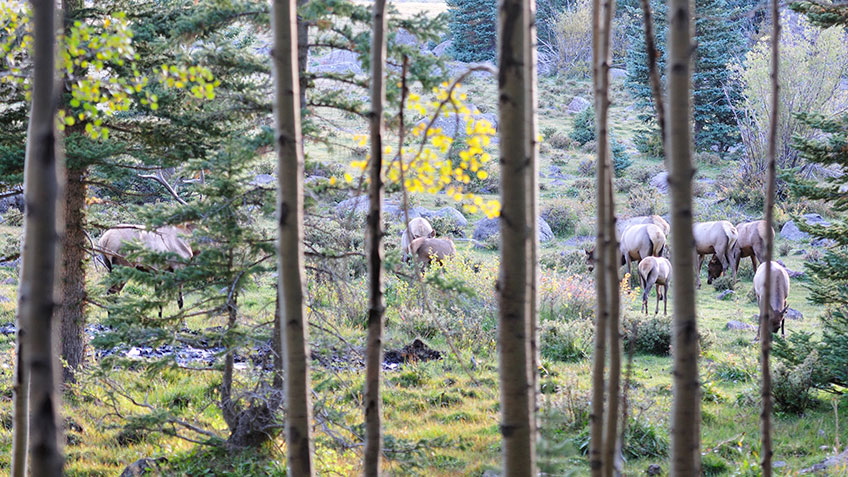
Regardless whether you’re hunting with longbow, recurve, compound or crossbow, bowhunting elk can be the most exciting hunting you’ll ever experience. It can also be incredibly slow and actionless. Here are ten tips that will help make your fall elk hunt a great one.

1. Get in Shape
You’ve heard it before, but it bears repeating: Be in the best shape you can before your elk hunt. There are not many experiences as disheartening as watching a big bull and his harem pass just out of bow range because you were too winded to get into position. Focus on three areas: cardio, legs and weight bearing. Cardio so you can charge up those high-elevation hills when the moment of truth arrives; legs for the same reason; weight bearing because you’ll almost always have a pack on your shoulders—a heavy one if you take an elk.
2. Practice
Work with your chosen archery equipment until you’re comfortable shooting from your knees, under branches and over brush. Practice shooting steeply uphill and downhill; stretch your range as far as you ethically can. Shots can be long, steep and challenging in elk country, and the better prepared you are to make a tough shot the more likely you are to make meat.

3. Be Bivy Ready
One of the most effective tactics in my toolbox is to sleep on the mountain with the elk. Get a super-light bivy camping setup and learn how to use it. That way, you’ll have your camp on your back and be ready to spend the night wherever the elk take you. Make camp a few hundred yards downwind of the elk, moving with them at night if necessary, and make your stalk in the grey light of dawn. Elk expect you to be hiking up the trail that time of day, not in their bedroom.
4. Find Elk
The hardest part about elk hunting is often finding the elk. Employ three senses for this: hearing, sight and smell, in that order. Spend lots of time on ridge tops and vantage points listening for a distant bugle or a cow chirp. Scan distant hillsides with your binoculars while you listen. You can blow locating bugles to inspire elk to be vocal. Send a bugle, wait and listen for two minutes, then send another. After that, wait 15 minutes and try again. In areas with a lot of pressure from hunters or wolves, you may need to do this at night (don’t hunt at night, just locate), and pay attention to the wind. I’ve often found elk by their sweet barnyard odor drifting on the breeze.

5. Hunt Hidey-Holes
Elk don’t like pressure. If bothered by hunters or wolves they will dive into the nastiest, thickest, steepest places they can find. A bit of feed, a little water and a lot of security cover is all they need. If elk are scarce, start looking for gosh-awful nasty hidey-holes that other hunters are reluctant to venture into; you’ll have the elk all to yourself.
6. Sound Like an Elk
Nowadays elk have heard it all, and are rather adept at picking out a fake—especially the suspicious old matriarchs of the herd. The slightest mistake, and the elk you worked so hard to find will be headed for Canada. To circumvent this you need to call sparingly, and sound like a herd of elk. Snap twigs, rustle brush, and knock a stick against a deadfall log to sound like a hoof hitting. Rub a tree a little to sound like an aggressive bull. When you blow a cow call, only call one time. Often the first call will get the elk’s attention, the second will relay that you’re a fake. Wait a few minutes before calling again.

7. Tag-Team Bulls
The exception to the above advice is a testosterone-charged bull. If you find a bull that bugles immediately and hard in response to your cow calls, call back often and seductively. The best setup is done with two hunters, one working the calls, moving back and forth, snapping twigs and deploying a decoy if he’s got one. He can even move away, calling as he goes, if the bull hangs up out of range. The second hunter sets up 40 to 100 yards in front, on the downwind side of where he expects the bull to come through. This hunter should never call except to signal his partner that he’s in position or that he’s taken a shot. That way the bull’s attention is on the caller, and with luck he’ll walk right by the hunter, offering a close, clean shot opportunity.
8. Set Up in Front
One of the most common mistakes rooky elk hunters make is to set up with plenty of cover between them and where they expect the elk to show up. Leave your whitetail skills at home on this one, and set up with cover behind you to break up your outline, but only minimal cover in front. Compared to whitetails, elk can be pretty oblivious. Paint your face and hands, kneel on the ground with your bow at the ready, and hold still; elk will walk right by and never spot you.

9. Hunt Midday
Elk are very aware that most hunters head back to camp for lunch and a nap. They relax a bit, browse around and get a drink if one is handy. Bulls are often tired from rutting all night, but after a nice late-morning nap feel the urge to initiate a little action. It’s one of the best times to call a herd bull away from his harem. One of my favorite strategies is to set up downwind of a favored wallow and waterhole. If elk are nearby it’s only a matter of time till one shows up for a drink—and chances are good it’ll be the herd bull.

10. Be Aggressive
Timid hunters don’t kill many elk. Don’t hesitate to make an aggressive move if necessary. Move quickly to adjust your setup or cut off a herd. As a last-ditch effort, you can charge right into the herd. They’ll often mill in surprise for a few seconds, giving you a chance to arrow one of them. Once they bust and run, you can run after them for a minute, then call frantically like a lost cow—the herd bull just may turn around and come back for you. Another brazen tactic that can pay off big is moving in fast on a rubbing bull. If a bull is actively rubbing his antlers on a tree, his eyes are mostly shut. I’ve walked right up to within single-digit yards of bulls preoccupied with venting their frustrations on a tree. You can do the same; just close the distance fast, draw your bow and put a steady shot into his vitals. It’ll be your most exciting bowhunting experience ever.



































